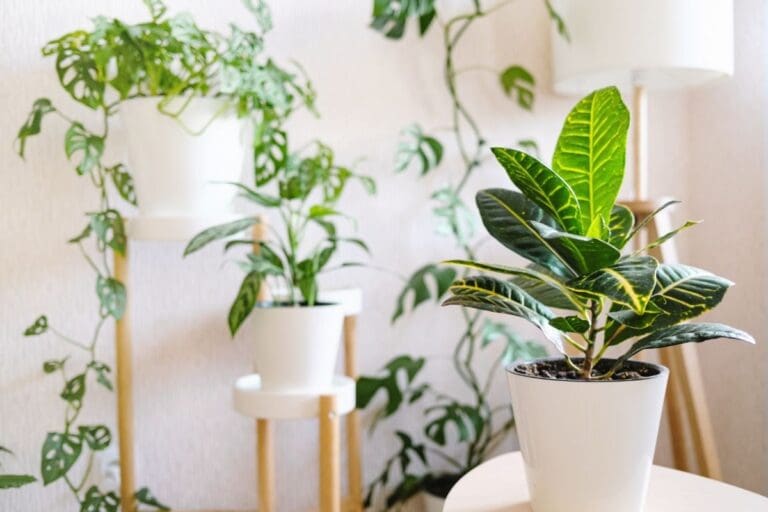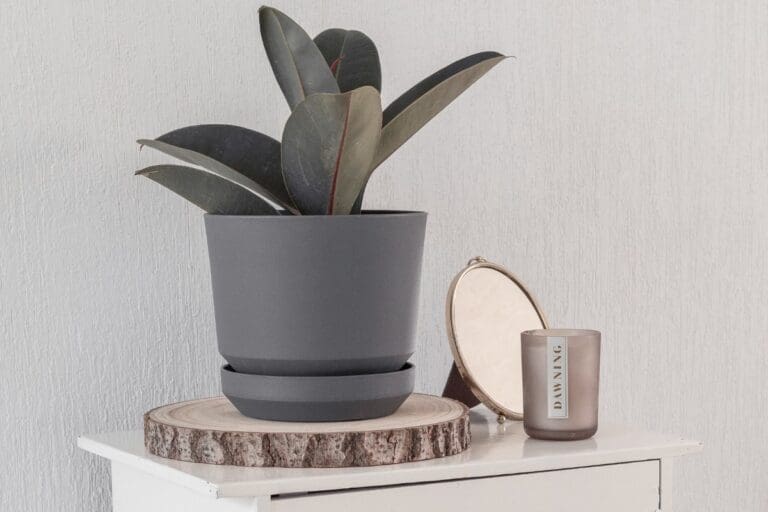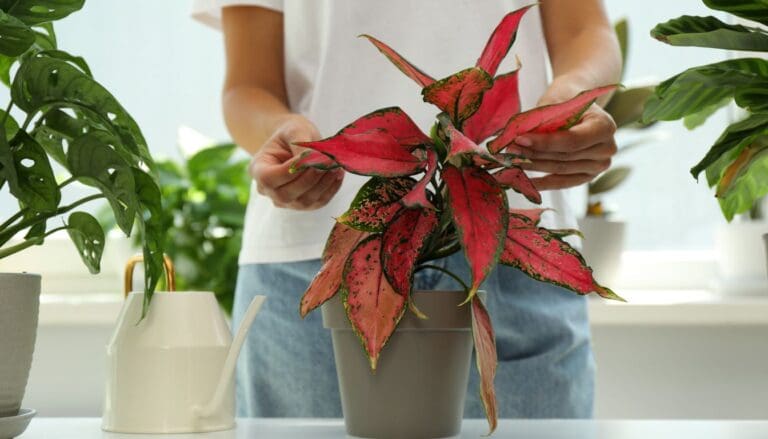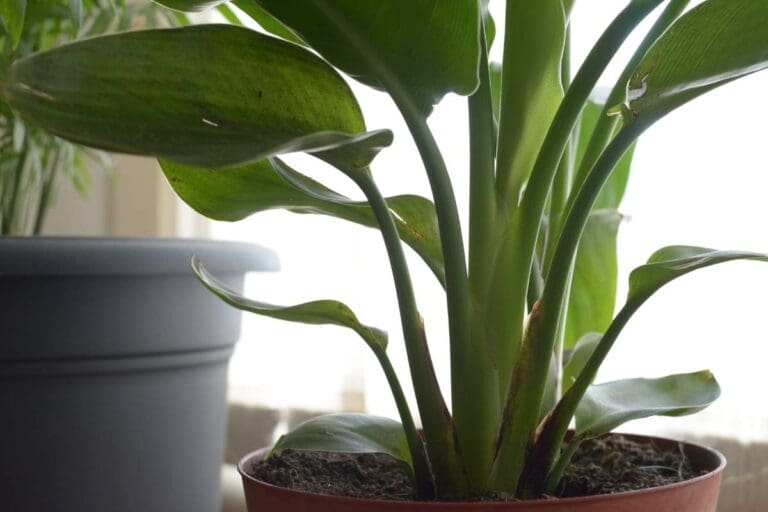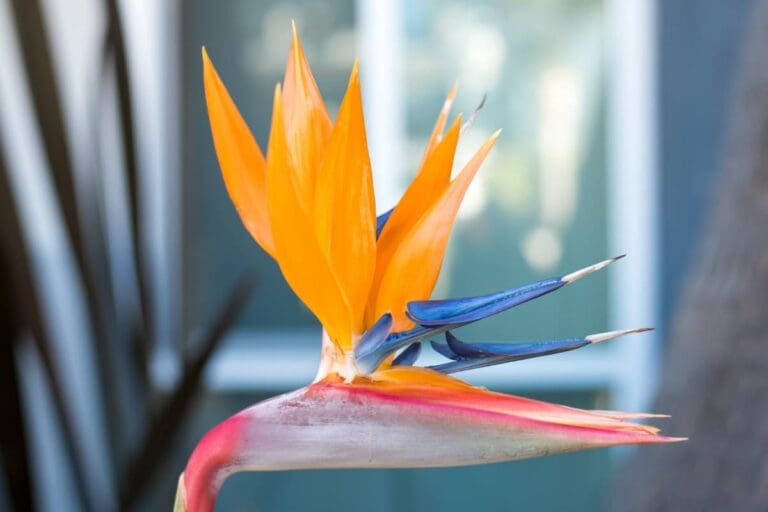How To Care For Chinese Evergreen? (Aglaonema Care Guide)
Chinese Evergreen, also called Aglaonema, is a popular tropical plant loved for its beautiful patterned leaves. They are forgiving and durable plants that can endure poor lighting, dry air, and drought conditions.
However, your plant will require proper care to thrive. So, in this article, we shall learn how to care for Chinese evergreen.
In general, Chinese Evergreen requires bright indirect sunlight, well-drained soil, temperatures above 65°F, and 40-60% humidity to stay happy. Try to keep them at an appropriate spot away from cold drafts. Also, fertilize them once a month during the growing season.
There are many more things you should know about Chinese Evergreen. With accurate information, fixing the problems and keeping the plant healthy will be effortless.
We have explained everything about the plant in this guide about the characteristics, basic needs, troubles, and fixations.

Please note: Simplify Plants is reader-supported. Some links in the post are affiliate links and I get a commission from purchases made through links in the post.
Chinese Evergreen overview
Chinese Evergreens are native to the tropical and subtropical areas of Asia and New Guinea. They are a genus of flowering plants belonging to the arum family, Araceae. These plants signify good luck and richness in Chinese culture.
Though belonging to the flowering family, Chinese Evergreen does not have any blossoms to show off.
The blooms look very small, like peace lily flowers. Generally, Chinese Evergreen is loved more for their leaves: the different looks, patterns, and colors.
The name Aglaonema was derived from two Greek words, Aglos, meaning shining, and nema, meaning thread. It depicts the shiny bright colors and patterns drawn all over the leaves. There are lots of white, pink, red, orange, and yellow tints all over the leaves.
Typically, a Chinese Evergreen will grow 1-3 feet in height. They grow faster in summer and slow down in winters. They are naturally moderate to slow growers.
Are Chinese Evergreen indoor plants or outdoor plants?
Chinese Evergreen plants are usually indoor plants that grow best under indirect sunlight and at room temperature.
Outside, they would be unable to tolerate direct sunlight or harsh cold temperatures. That is why Chinese Evergreen is considered a typical houseplant.
If you want, you can try growing them outdoors. These plants will grow efficiently outside as long as they receive indirect sunlight and the temperature in that region doesn’t drop below 55°F.
Also read: Can Chinese Evergreen Grow Outside? (When & Where)
Varieties of Chinese Evergreen
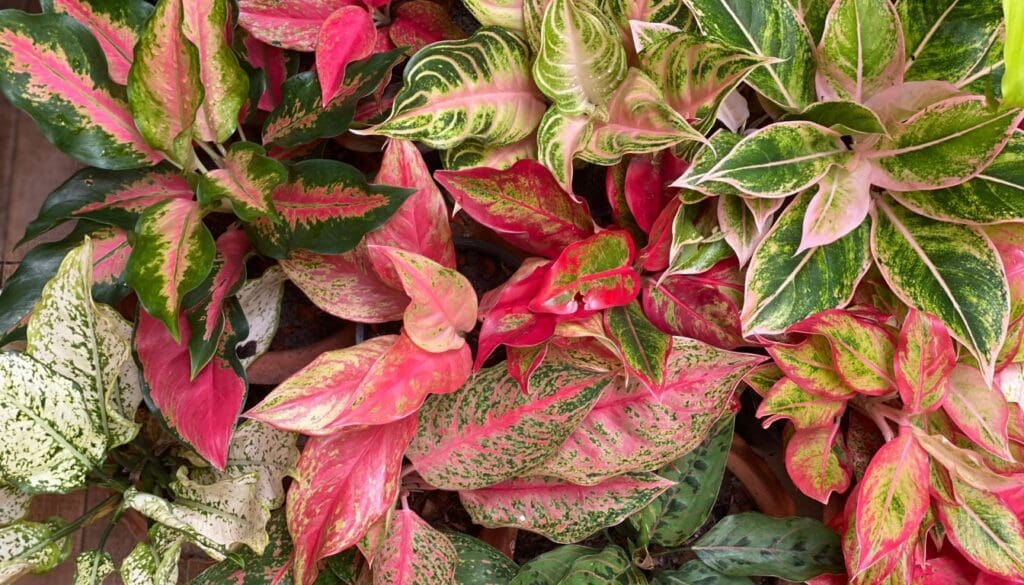
Chinese Evergreens are loved especially due to their different stunning and colorful patterns. Some are even available in plain green.
Aglaonema Siam Aurora: The leaves of these varieties have beautiful pink edges. The veins also hold pink color while the rest is green. Such combinations of green and pink make the plant appear attractive.
Aglaonema Silver Queen: This variety is pretty and appealing. The leaves are finely marbled that seem silvery green. The leaves of this kind are lance in shape. Their foliage grows slightly upwards.
Aglaonema Maria Christina: Their pattern is somewhat similar to the Silver Queen variety. The only difference is that the silvery color is less and the green shades are more. They are also an easy-to-care plant.
Aglaonema Emerald Star: Emerald Stars are the best varieties because of their ability to endure cold temperatures ranging from 45-50°F and even below. Even being exposed to such low temperatures, this variety rarely shows any signs of cold injury.
The other two types that tolerate cold temperatures like Emerald Star are Jewel of India and Stars.
Other varieties of Chinese Evergreen are:
- Silver bay
- Emerald beauty
- Golden bay
- Firecracker
- Calypso
How to plant a Chinese Evergreen?
Here is how you can plant a Chinese evergreen in a pot.
- Take a pot according to the plant size. Use a 1-2 inches bigger pot than the present for repotting.
- Now fill the pot 1/4th with the soil.
- Some growers add pebbles at the bottom for good drainage. If your container has drainage holes, avoid pebbles.
- If you are repotting, gently tap the sides of the pot to loosen the soil.
- Remove the maximum amount of old soil from the root portion.
- Cut off the affected roots, if any.
- Now place the plant at the center.
- Add the rest of the soil mix around the plant to cover the roots. Press gently.
- Water the soil thoroughly. Add more soil if needed. Let the extra water drain out of the container.
- Place the plant in its preferred position.
Also read: When To Repot Chinese Evergreen? (Signs, Essential Supplies+How To)
Chinese Evergreen care guide
Once you get accustomed to all the basic requirements, caring for the plant to enjoy them in the long term will be easier for you.
However, it is usual to do something wrong while growing them at some moment. Reading this Chinese evergreen care guide till the end will help you learn and fix the mistakes to improve the plant’s health. So let’s begin.
Light requirements

In their native land, Chinese Evergreen grows in humid surroundings in shady tropical forests in Asia. It must have given you a hint about the light requirements for these Evergreens.
As I mentioned earlier, these are low-maintenance plants. Surviving even under low light conditions makes them more ideal for growing indoors.
They will love to grow near north or east-facing window that receives perfect indirect light and morning sun.
Never expose them to direct sunlight. If you placed these plants near a south or west-facing window, keep them near the window during the morning and late afternoon.
In the other times, like the middle part of the day and afternoons, bring the plant a few feet back from the window. You can also use window films or transparent curtains to filter the direct sun.
These plants will grow readily in office set-ups under fluorescent light in the daytime, without any windows. It means they will be thriving under grow lights too.
Chinese Evergreen can grow under low light doesn’t mean they don’t need light at all. An ample amount of indirect light will maintain the balance of the plant.
Some varieties require more light than the other varieties. For example, the highly multicolored varieties require more light than the dark green varieties. An ample amount of sunlight also helps to maintain their color.
Also read: How Much Light Does A Chinese Evergreen Need? (Light Requirements)
Soil mix for Chinese Evergreen
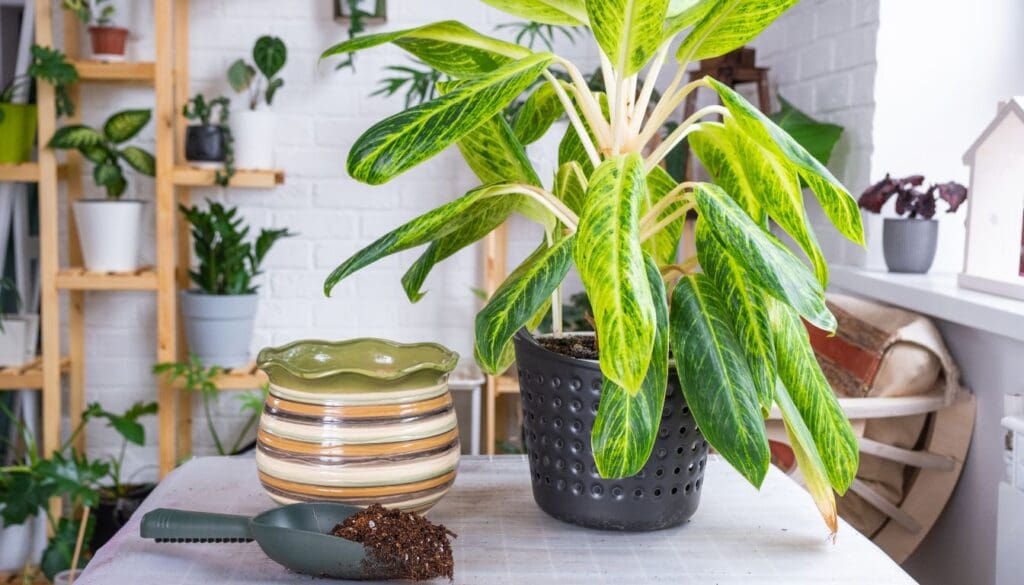
Chinese Evergreen will need lightweight and well-drained soil to thrive. They will need peat-based soil rich in nitrogen. Because these plants show off their foliage more, nitrogen-rich soil will maintain the health and color of the leaves.
Additionally, the pH level of the soil mix should range from 5.6 to 6.5.
Some recommendations are:
Recipe 1
- 30% Potting soil
- 25% Vermicompost
- 25% Cocopeat/Peatmoss
- 20% Perlite
Recipe 2
Recipe 3
- 3 parts Potting soil
- 1 part Perlite
Also read: What Kind Of Soil Does A Chinese Evergreen Need? (+Best Soil Mix)
Watering needs

Read this point attentively because even experts commit mistakes following a good watering schedule for houseplants. Every point is important because having a healthy Chinese Evergreen for a long time depends upon the stability in care.
Generally, you should water an Aglaonema when 50% of the topsoil dries out completely. They need deep but infrequent watering. They will neither enjoy dry conditions nor will they like being overwatered.
Though Chinese Evergreen can tolerate dry soil to some extent, overwatering can be dangerous.
You can water Chinese Evergreen once a week during warmer conditions and every 2-3 weeks during winter. They remain dormant in winter, so they will not absorb water as fast as spring and summer.
The watering schedule also depends on the pot you are using. If you take a clay or terracotta pot that tends to wick away moisture quickly, you will need to water the Chinese evergreen more often.
The best way is to check the moisture level by finger. When the top 1 or 2 inches feel dry, water your Chinese evergreen well until the extra water runs out of the drainage holes. Drainage holes are mandatory.
Also read: How Much Water Does A Chinese Evergreen Need? (How Often+Summer & Winter)
Fertilizing

Chinese Evergreens are less demanding when it comes to fertilizing. Use a balanced liquid fertilizer with NPK value 20:20:20.
You can also try fish emulsion or liquid kelp. These two will work the same as liquid fertilizer. Whatever you are using, dilute it to half the strength.
Fertilize the Chinese Evergreens during the months of spring. If you think the plant needs more food, feed them again with the same fertilizer and strength in summer.
Don’t fertilize during the fall or winter. Chinese Evergreens start going dormant once the fall arrives and hibernates during the cold months.
Don’t over-fertilize your plants because the build-up of salts will burn the root system. Additionally, do not feed a stressed plant, i.e., a bone dry or damp plant.
Also read: Does Chinese Evergreen Plant Needs Fertilizer? (How Often+Best Fertilizer)
Temperature tolerance
Chinese Evergreens enjoy growing when the temperature ranges from 68 to 77°F. Such temperatures are the same as the room temperatures. That is why Chinese Evergreens are popular more as houseplants.
Some varieties will endure 55°F or below temperatures and grow without any signs of cold damage.
India’s Emerald Star, Stars, and Jewel can grow under temperatures below 55°F without showing any damage signs. If you live in a cold region, grow these varieties.
Also read: How Cold Can Chinese Evergreens Tolerate? (Chinese Evergreen Cold Tolerance)
Humidity

Chinese Evergreens will enjoy high humidity because they are tropical plants. They will do great if they receive about 40 to 60% humidity. Assure that the humidity level never goes below 40% because it is the minimum percentage to be endured.
For maintaining the ideal humidity, you can mist your plant. But misting doesn’t work for long.
Fixing a humidifier in the room will solve problems related to low humidity. A humidifier can mimic the same humidity range as the plant’s native land.
Other methods include placing pebble trays under the pots or grouping the plants. These will help to increase at least 15% of humidity.
Also read: Should I Mist My Chinese Evergreen? (+Humidity Guide)
Pruning Chinese Evergreen

Usually, Chinese Evergreens require pruning to get rid of the dead flowers and yellow or brown leaves.
The yellow or brown leaves indicate that the plant is aging or facing some issues. These leaves will not turn green. Pruning these leaves will help restore energy so that the plant can concentrate on making more green leaves.
Use a disinfected pruner to trim off the dead flowers and leaves. Wait until the leaves become dead enough to be easily pulled off.
Also read: How To Prune Chinese Evergreen? (Step-by-Step Guide)
Potting and repotting
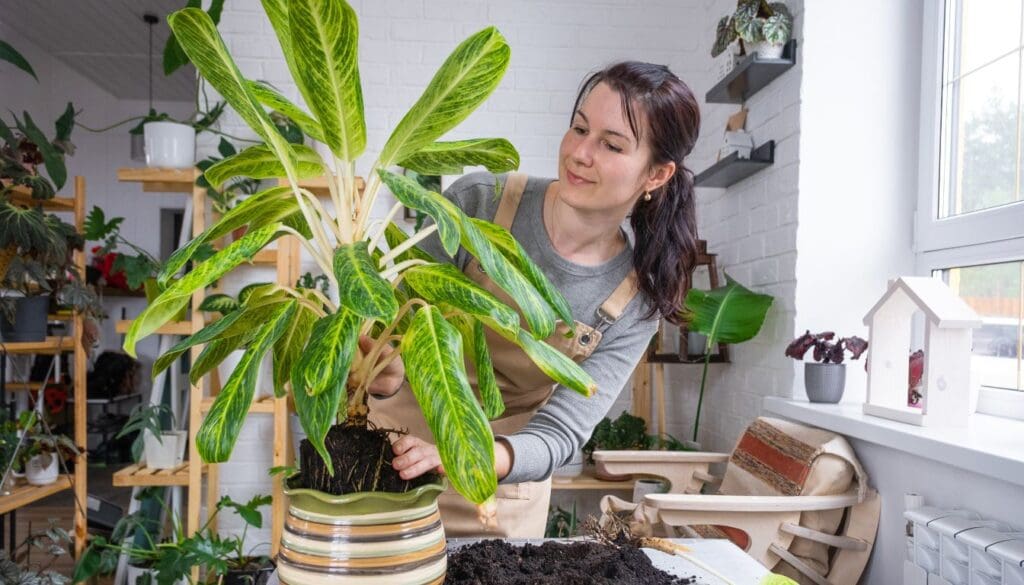
For choosing a planter for Chinese Evergreens, take a pot size depending on the plant. Don’t choose a too small or too big container. These plants enjoy secured and dense roots.
Select a container having a 1-inch diameter wider than the plant’s root mass.
Chinese Evergreens are moderate to slow-growing plants. They will need re-potting every 2-3 years. Repotting in a new pot with fresh potting mix rejuvenates the growing medium and improves the plant’s health with new nutrients to boost them.
Repotting will also give you the chance to divide and propagate the plant to get more Chinese evergreens.
While repotting, the size of the container should be 1 to 2 inches bigger than the existing one. Do not go for a too-big container because that will need more soil which will take forever to dry, thus causing overwatering.
Whatever pot you are choosing, make sure it contains drainage holes. If it doesn’t have drainage holes, use a planter having cachepot with drainage holes within the main pot.
Bring the plant and the cachepot outside, water until the excess water drains out completely, and keep it back in the original container again.
Also read: When To Repot Chinese Evergreen? (Signs, Essential Supplies+How To)
Pot type

You can use any planter of your choice.
If you have a terrible habit of overwatering, grab a clay or terracotta pot. It can wick away moisture.
If you are too busy to follow a watering regime regularly, use plastic pots because they will hold moisture for long periods. Just know that they will not appreciate overwatered situations.
Though these plants can endure dry conditions to some extent, they shouldn’t be dry for long. So, relying on these conditions and your way of watering, choose the planter wisely.
Also read: What Kind Of Pot For Chinese Evergreen? (Pot type, Size, Material & More)
Propagating Chinese Evergreen

Chinese Evergreens are propagated both in water and soil. Though there are many ways to propagate Chinese Evergreens like stem cuttings, root cutting, seeds, and tissue culture, stem cutting is the easiest way to propagate.
Tissue culture is usually performed when you need many seedlings growing quicker than usual by using small plant parts like leaves, stems, or roots. Tissue culture works well in a lab environment.
Cuttings are usually taken from lateral and apical shoots or by cutting pieces of trunk having some leaves. For fast growth and rooting, use the stem cutting method.
Propagating Aglaonema cutting in soil
- Take a healthy plant and cut the stem from the base of the plant. Make sure that the stem must be 2 to 3 inches.
- Cut it and plant it in the potting mix with equal parts of soil and perlite.
- Get rid of a few leaves from the base of the cutting.
- Place the cutting under indirect sunlight and water enough just to keep it moist all the time. Moist soil will improve the rooting of the plant. Though the perlite will absorb excess moisture levels, you shouldn’t overwater the cutting.
- Don’t expose them to cold temperatures and maintain a humidity of about 40 to 60%.
- You can apply some fungicide or root hormone to the cutting area. It will prevent fungus infections and encourage fast root growth.
- Separate the mother plant with roots from a healthy plant for propagation by root cuttings.
- Keep this new plant in a new container and soil mix. Place it under indirect sunlight and warm temperatures. Within 5 to 10 days, new roots will start growing.
Propagating Aglaonema cutting in water
The cutting process is the same as in the soil propagation.
- Cut a healthy stem of a Chinese Evergreen about 2 to 3 inches.
- Place the cutting in the water. Cut diagonally. It will ensure that the bottom of the cutting doesn’t sit entirely on water.
- Change the water either 2-3 days or once a week. Use a glass jar or container. You can see and understand the condition of the water. Whenever the water starts turning cloudy, change it.
- You can either let the plant remain in the water or transfer it to the soil once the roots grow 1 inch.
Many growers say that Chinese Evergreens do not root well in water. But with proper care, they will stay healthy in water. If your plant doesn’t do well in water, you can shift it to the soil.
If you want the Chinese evergreen to stay in the water, keep them under indirect sunlight, change the water every week, fertilize with a few drops of water-soluble fertilizer.
Propagating by seeds
Most people propagate by stem cutting because it is very efficient and quick. If you want to try something alternative, I would still like to share the seed propagation.
Seed propagation is very time-consuming. If you are okay with it, try it. The seeds must be fresh. You can collect the seeds from the base of the mature plant flowers. Wash the seeds nicely in water or acidic water.
For soil mix, use either coco-peat mix or seed germination soil mix. Now spread the fresh seeds over the soil evenly and cover them lightly.
Place the container in a spot receiving indirect sunlight and room temperatures. Within 45 to 60 days, they will begin to germinate.
Also read: How To Propagate Chinese Evergreen? (Step-by-Step Guide)
Chinese Evergreen toxicity
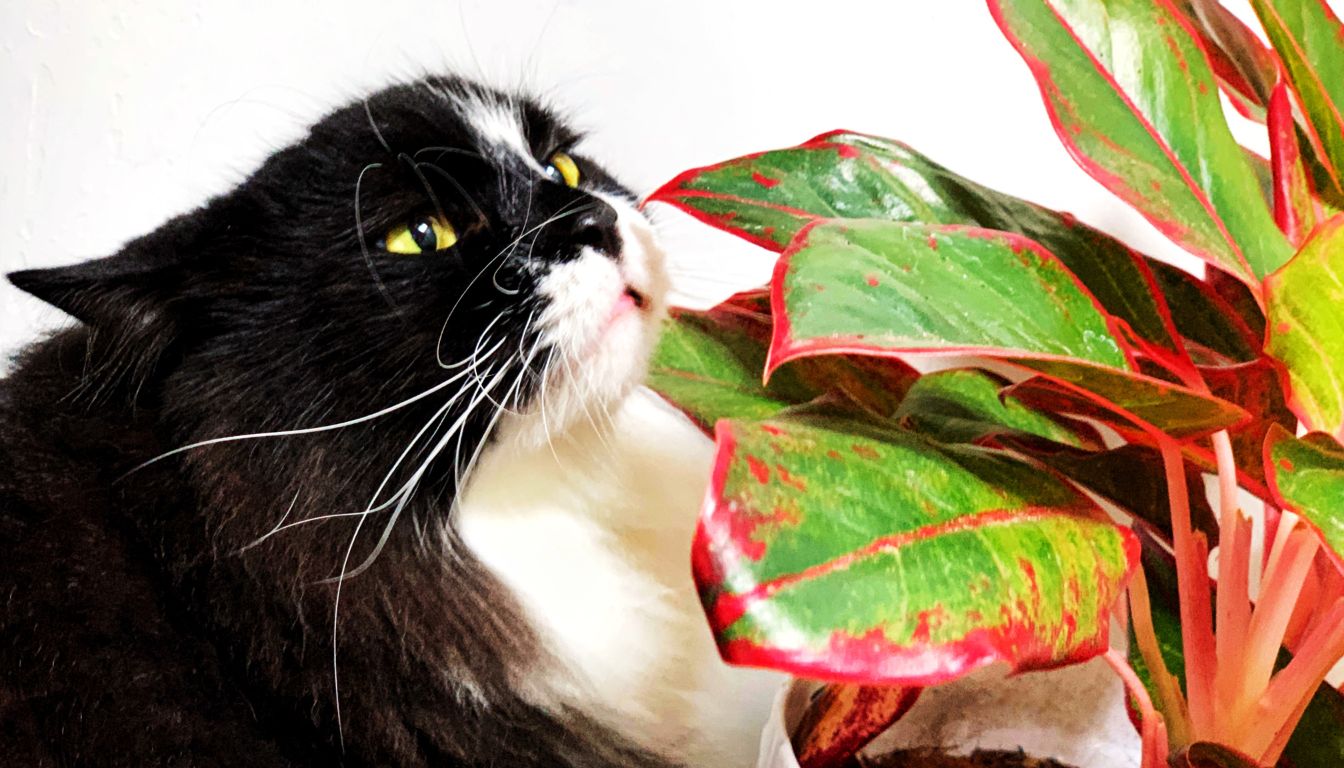
These plants are declared toxic to dogs and cats by the reputed American Society for the Prevention of Cruelty to Animals (ASPCA). The plant contains calcium oxalate crystals.
Some varieties even produce berry-like fruits that are also poisonous for pets. They are equally bad for human beings.
When ingested, the pets, especially cats and dogs, will have pain, irritation, and swelling inside their mouth, tongue, and lips. They will even experience vomiting and face difficulty in swallowing food.
If you have pets, children, and Chinese Evergreen, keep the plant out of their reach.
Benefits of having Chinese Evergreen
Though toxic and poisonous, there are many benefits of growing these plants indoors. They are attractive and easy to grow. Their appearance can give your interior space a distinctive look.
Chinese evergreens are also responsible for refilling indoor oxygen. They are declared a purifier for indoor air by the renowned NASA’s Clean Air Study.
The plant helps remove the formaldehyde and benzene toxins from the air we breathe.
Common problems in Chinese evergreen plant
Chinese Evergreen will have common problems like yellow leaves, brown leaves, curled leaves, droopy leaves, greasy dark patches, etc. Identifying the signs encourages easy fixation of the plant.
The probable reasons behind these problems include improper watering, direct sunlight, low humidity, exposure to cold temperatures, over-fertilization, or poor drainage.
Sometimes these problems are not problems. Some signs are signs of aging. But when many leaves together show signs like yellowing/browning, it is probably a sign of damage.
Yellow leaves

The most mutual cause behind yellow leaves in Chinese Evergreen is overwatering. The situations responsible for overwatering are frequent watering without checking the moisture level and poor drainage.
If you use the soil mixes I recommended earlier in this article, your Chinese Evergreen will rarely undergo overwatering. Perlite and sand help in improving drainage.
Water the plant only when the top 1-2 inches of soil feels dry.
The container should have enough drainage holes such that excess water comes out of it. Otherwise, the soil will be soggy, increasing the chances of root rot, another nightmare.
They can also suffer from underwatering. Along with yellowing, the leaves will be drooping. The lower leaves show more signs of damage.
Do not expose them to direct sunlight as it can cause yellow leaves, especially in the variegated varieties.
Chinese Evergreen will grow readily under indirect sunlight. Under absurd sunlight conditions, the leaves will have sunburns, causing brown patches all over the leaves.
Every plant will suffer repotting stress. It may include yellow leaves, brown leaves, or leaves falling off.
If you have recently repotted your Chinese evergreen, it may show yellow leaves. Don’t panic. It will take time for the Chinese evergreen to adapt to a new environment. Just make sure not to stress them further by overwatering or light issues.
Low humidity will also result in yellow leaves. The humidity should not drop below 40%. Fix a humidifier to give the plants the exact humidity like their native land.
Another reason is pest infestation. Sap-sucking pests suck away all the juices from the plant, driving it lifeless. It provokes yellowing of leaves due to lack of saps.
Also read: Why Are My Chinese Evergreen Leaves Turning Yellow (Causes+Fix)
Chinese Evergreen leaves turning brown

Again, the reasons are the same as the yellow leaves. When it comes to watering, browning at the tips and edges is due to root rot.
The leaves turn yellow and brown and damp in overwatering, triggering root rot in severe conditions. Root rot is a life-threatening problem for Chinese evergreens. It can also happen due to improper drainage.
In underwatering or lack of moisture, the brown tips and edges of the leaves feel dry and crispy. If it is low humidity, fix a humidifier to increase humidity. It shouldn’t drop below 40%.
Following the watering schedule, I explained earlier in this article can help you prevent such conditions. To treat the plant from overwatering, you need to stop watering immediately.
You might need to re-pot the plant with new soil and pot for treating root rot. Along with that, you have to prune off the damaged, dark brown, and mushy roots.
Another reason for brown leaves includes fungal diseases due to prolonged damp leaves. Avoid overhead watering. Water the plant near the soil at the base.
Chinese Evergreens will show signs of cold injury like brown foliage and dark greasy patches when they receive temperatures below 55°F.
To fix this, remove the affected leaves and relocate them to warmer areas in your home. During the cold months, mulch the soil with dry barks and leaves so that the cold temperature doesn’t reach the roots.
Exposing them to excessive light also causes brown patches on the leaves, indicating sunburns. Chinese Evergreen will require indirect light.
Direct sunlight affects and weakens their health. Relocate if you ever exposed the plant to direct sun. Prune off the brown leaves.
Also read: Why Is My Chinese Evergreen Turning Brown? (Possible Problems+Fix)
Chinese Evergreen leaves curling

Curly leaves in these plants can result from underwatering, temperature stress, low humidity, or exposure to direct sunlight.
Chinese Evergreen loves moisture. Constant dry air will make the leaves curl. When they are kept in places that are too dry around, along with the soil, the leaves too will begin to lose moisture, resulting in curly leaves and even droopy leaves.
Fixing a humidifier will be the best solution for this problem. There are other ways like misting, grouping plants, and pebble trays. You can try any one of them.
Over-fertilization causes the accumulation of excess salts. This salt can burn and destroy the roots. The salts are spread in the whole plant through watering, further resulting in the curling and browning of the leaves.
To stop this, you should flush off the soil. Chinese Evergreen doesn’t have much demand in fertilization, so it is better not to bother them with frequent fertilizing.
Also, avoid fertilizing in winters. In the spring, feed them with a 20:20:20 liquid fertilizer.
Pest infestation is another reason for curly leaves. The common pests are aphids, spider mites, scales, and mealybugs. They will love to feed on the saps of the plant, making the plant weak and curly.
You can spray neem oil if you want organic treatment. Neem oil is safe and very effective in removing pests. In severe conditions, you have to use chemical insecticides to kill them.
Also read: Why Are My Chinese Evergreen Leaves Curling? (Causes+How To Fix)
Leggy Chinese Evergreen
Due to improper care, the Chinese Evergreen will become dry and yellow, especially when they are kept in dry conditions for a long time. It will also become leggy.
Primarily, the older plants are to suffer the most.
Fixing a leggy Chinese Evergreen is not a tough job. You can prune the leggy part and propagate it in soil or water. Read the propagation point for further details.
Do not prune a healthy plant that is already in good shape.
If your Chinese Evergreen is bushy enough but contains some legginess, pruning the leggy portion can help replenish the plant’s growth and development.
If your plant is growing actively, do not prune them. For a leggy plant, remove the leggy portion above the node. It promotes bushy plants.
The reasons behind a leggy Chinese Evergreen can be small pot, over-feeding nitrogen-based fertilizer, and extreme low light conditions.
When grown in a small pot, the plant will constantly grow upwards for more space. Slowly it will outgrow the container, thus making it look leggy.
Use a container according to the plant size. Follow the “Potting and Re-potting” point to know more.
Sometimes growers feed the plant with high nitrogen-content fertilizer. Because nitrogen helps in good foliage growth, receiving excessive nitrogen in their growing season can result in a leggy plant.
Feed them with a balanced fertilizer with NPK 20:20:20.
Chinese Evergreens accept low light doesn’t mean they don’t need any light. They require bright, indirect light without any direct exposure to the sun.
Too low light will make them leggy, signifying that the plant is trying to reach some light. Place them near the north or east-facing window.
Copper deficiency in Chinese evergreen
When the plant suffers copper deficiency, the new leaves become yellow, striped, and disfigured. In severe cases, the Chinese evergreen will end up dying. To fix the problem, use a fertilizer that contains copper as a micronutrient.
The affected leaves will not revive back. Remove them to save energy and focus on growing new leaves instead of wasting the energy to revive the affected leaves.
Droopy and limp leaves in Chinese Evergreen

More or less, all the reasons are the same behind all leaf problems. In the case of droopy leaves, too, it is improper watering, over-fertilization, low humidity, cold injury, and fungal infections.
Follow the care guides to understand the correct methods of watering, fertilizing, and light requirements. To fix the problems, you need to stop bothering the plant first.
If it is watering or fertilizing, stop it from giving them time to recover from the stress. In case of light, shift your plant to partial shade.
Chinese Evergreen doesn’t enjoy cold temperatures at all. Though they can tolerate incorrect care, they cannot endure cold. Very few varieties of Chinese Evergreen can bear cold.
The temperature should not go below 60-65°F. Along with droopiness, yellow or brown foliage and dark greasy patches too are signs of cold injury.
To treat them from fungal or bacterial infections, you need to isolate the plant first and identify the problem. Most fungal infections happen due to stress like inadequate watering and root rot.
So, you must be careful about watering these plants. Prolonged damp conditions can attract fungi.
Pest infestation will also cause droopy leaves. To fight pest infestations and diseases, read further.
Also read: Why Is My Chinese Evergreen Drooping? (Possible Problem+Fix)
Pests and diseases in Chinese evergreen plant

Handling pests in houseplants is common for all houseplant owners. The common bugs found in Chinese Evergreens are aphids, spider mites, mealybugs, scales, and nematodes.
These pests attack the plant, particularly when facing stress like prolonged droughts, wet conditions, or Saltburn.
Mealybugs: These pests accumulate on the stems and leaves like tiny white cotton. They suck out all the saps from the plant. It results in stunted growth, leaves falling off prematurely, and pale leaves.
You won’t like to see such conditions in the plant destroying the appealing and stunning look of the leaves.
For treating a small infestation, wipe off the leaves with cotton and rubbing alcohol. For larger infestations, neem oil and insecticidal soaps will work well.
Aphids: Aphids have soft bodies that are light green, found under the leaves. They also suck all the juices from the plant.
A small infestation doesn’t cause much damage, but a significant infestation results in stunted growth, deformed leaves, and sticky leaves.
This sticky substance is the honeydew they release after feeding. This stickiness will again lead to powdery mildew.
Treating and removing aphids is no different than mealybugs. You can try showering the plant with a stabilized water pressure so that all the aphids fall off the plant. Then wipe the leaves to remove the leftovers.
Spider mites: You will find fine web-like structures on the edges and surface of the leaves.
When you inspect the leaves, you will notice small black moving dots. These symptoms claim that your Chinese Evergreen got infested by spider mites.
Small infestation is a nuisance but, large infestation leads to yellow leaves falling off impulsively. The root cause behind their infestation is overwatering.
For a small infestation, rub the leaves with a damp paper towel. For a huge one, follow the same as Mealybugs.
Scales: Small bumps moving across the leaves and stems of the Chinese Evergreen signifies scale infestation. A bug that feeds on the phloem sap of the plant results in falling leaves, weak plants, and dying stems.
In most cases, scale infestation is not visible until their infestation becomes immense. Horticulture oils and insecticidal soaps are needed to remove them or kill them.
Nematodes: These attack the Chinese Evergreen when they are grown outdoors. It feeds on the roots, causing pale leaves and falling leaves.
Disinfecting the top 12 inches of the soil bed will help get rid of these pests.
Also read: Do Chinese Evergreen Get Bugs? (Common Bugs+How To Get Rid Of Them)
Diseases in Chinese Evergreen
The only way to eliminate the diseases is through prevention. Once the signs of damage are visible, the problem is already present.
Isolate the plant and stop committing the causes responsible for the diseases to avoid further stress. Rest, you can leave the plant on its own to give it time for recovery.
Anthracnose: Caused by the pathogen Colletotrichum, it happens when the leaves remain damp for long periods.
You will see round brown spots on the leaves with a yellow halo. The marks are 2 inches in diameter. To prevent this, stop overhead watering. Water the plant’s base close to the soil.
Bacterial leaf spot: The pathogen names are Pseudomonas cichorii, Erwinia chrysanthemi, or Xanthomonas campestris dieffenbachiae.
Always check the plant attentively before buying it. If the signs of disease are visible after bringing home, remove the affected leaves.
The common symptoms include tiny grey or dark green leaf spots that become bigger and crooked, tanned and dark brown or black. Avoid watering the leaves.
Myrothecium leaf spot: This disease is occurred by the pathogen Myrothecium roridum. The reason behind this is the excessive use of nitrogen-based fertilizer.
Use a balanced fertilizer (20:20:20) if you wish to avoid problems related to fertilizers. You can identify this disease when you find big grey-brown colored spots at the tips or edges of the foliage.
Fungal structures in ring shape within the marks will be visible beneath the leaves.
Final words
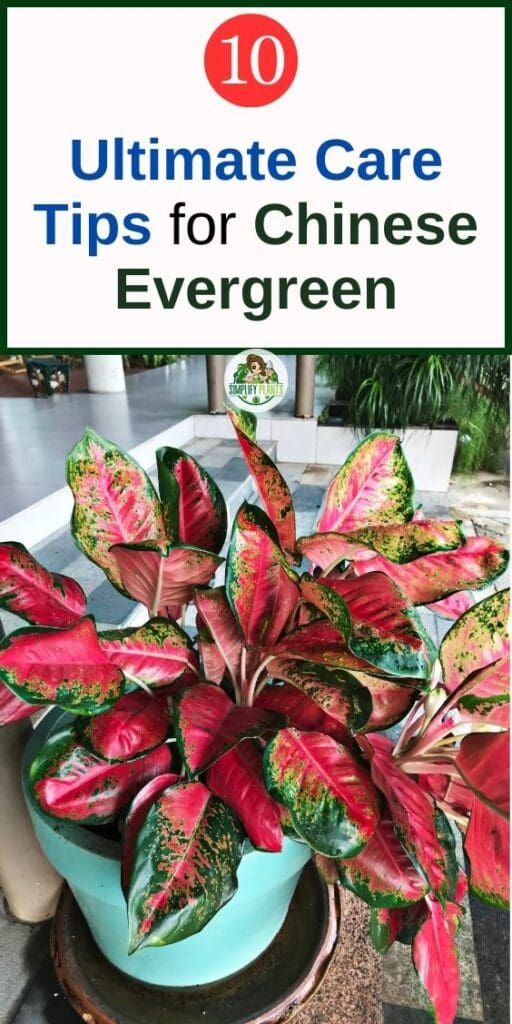
Let Chinese Evergreens have bright indirect sunlight. Don’t disclose them to direct sunlight. Place them near the north or east-facing window for an ample amount of filtered sunlight.
Water the Chinese evergreen once a week during the warmer months. If you are too busy to follow a watering regime, check the moisture level before watering.
If the top 1-2 inches of the soil feels dry, water the plant. Use distilled or pure rainwater. Avoid tap water.
Use well-drained, porous soil that can retain moisture and drains excess water. Making the soil mix recipes, I recommended before in this article, will do both.
Fertilize Aglaonema during the spring with a balanced fertilizer (20:20:20). If they want more, feed with another dose in summer. Make the strength half. Reduce fertilizing during the fall and stop in winter.
Maintain a temperature from 68-77°F. The minimum temperature should be 55-60°F. Ensure 40-60% of humidity around the plant. Repot the plants every 2-3 years. You can also try propagating during repotting to get more plants.
Reference: Wikipedia, Nasa clean air study, Missouri Botanical Garden, The University of Kansas, NC State University.
Recommended Garden Supplies
| Product Image | Our Recommended Gardening Supplies | Check Offers! |
|---|---|---|
Top Top
Top
Top
Top
Top
Top
Top
Top | rePotme Houseplant and Tropical Classic Potting Soil Mix | Check Offer On Amazon |
 Top
Top
Top
Top
Top
Top
Top
Top | Espoma Organic Indoor Plant Food | Check Offer On Amazon |
 Top
Top
Top
Top
Top
Top
Top
Top | GooingTop LED Grow Light 6000K Full Spectrum Clip Plant Growing Lamp | Check Offer On Amazon |
 Top
Top
Top
Top
Top
Top
Top
Top | Soil Moisture Meter | Check Offer On Amazon |
 Top
Top
Top
Top
Top
Top
Top
Top | Govee Hygrometer Thermometer, Bluetooth Enabled! | Check Offer On Amazon |
 Top
Top | LEVOIT Humidifiers for Large Room(Best For Plants) | Check Offer On Amazon |
 Top
Top
Top
Top
Top
Top
Top
Top | Upgraded DIY Automatic Drip Irrigation Kit, 15 Potted Houseplants Support | Check Offer On Amazon |
 Top
Top
Top
Top
Top
Top
Top
Top | Stainless Steel Heavy Duty Gardening Tool Set | Check Offer On Amazon |
 Top
Top
Top
Top
Top
Top
Top
Top | Bonide Insecticidal Soap | Check Offer On Amazon |
 Top
Top
Top
Top
Top
Top
Top
Top | Bonide 32 oz Spray Neem Oil for Organic Gardening | Check Offer On Amazon |
 Top
Top
Top
Top
Top
Top
Top
Top | Garden Safe Fungicide | Check Offer On Amazon |

